BeLonging: Caputo, Frorup, Mason
ON THIS PAGE YOU WILL FIND ANNOUNCEMENTS, ARTICLES AND REVIEWS OF BELONGING: CAPUTO, FRORUP, MASON, AN EXHIBITION OF WORK BY AMALIA CAPUTO, KENDRA FRORUP AND NOELLE MASON CURATED BY FGCU GALLERY DIRECTOR JOHN LOSCUITO AND ASSISTANT DIRECTOR ANICA STURDIVANT ON VIEW IN THE ART GALLERY AT FGCU FROM JANUARY 15 THROUGH FEBRUARY 26, 2015.
* * * * * * * * * * * * * * * * * * * * * * * * * * * * * * * * * * * * * * * * * * * * *
Tampa sculptor Kendra Fropup employs cadre of found objects to conjure memories of times past (01-28-15)
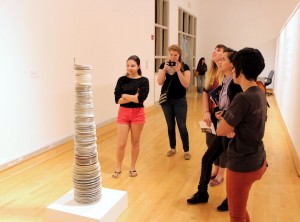 Two of the more popular pieces in BeLonging: Caputo, Frorup, Mason are Kendra Frorup’s teetering towers of saucers and plates made from actual Syracuse China. They look like they escaped the The Cat in the Hat, but their construction is far from random or haphazard. Rather, they allegorically suggest a result in which nothing fits but everything works. “The progressive concept of
Two of the more popular pieces in BeLonging: Caputo, Frorup, Mason are Kendra Frorup’s teetering towers of saucers and plates made from actual Syracuse China. They look like they escaped the The Cat in the Hat, but their construction is far from random or haphazard. Rather, they allegorically suggest a result in which nothing fits but everything works. “The progressive concept of 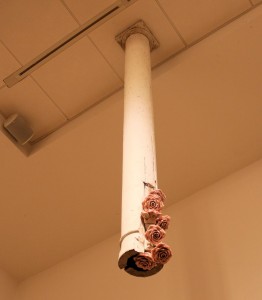 repetition in my work implies that repeated effort may be necessary to accomplish things and that the accomplishment is worth the struggle,” Frorup declares.
repetition in my work implies that repeated effort may be necessary to accomplish things and that the accomplishment is worth the struggle,” Frorup declares.
But pieces like China operate on a much more visceral basis. “My work is a lot about storytelling,” Frorup told an standing-room-only crowd during the Gallery Talk that preceded BeLonging’s January 15 opening. And to assist her in that endeavor, Frorup employs a cadre of found objects that she’s collected over more than a dozen years. “I’m attracted to things that remind me of something else” – that releases or triggers the recall of embedded 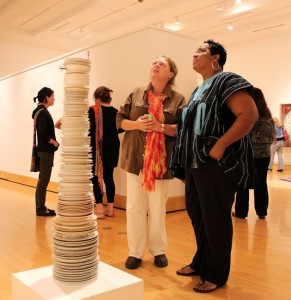 memories in the same way that the smell of a wood fire or perfume or the strains of an old song can suddenly transport you back in time.
memories in the same way that the smell of a wood fire or perfume or the strains of an old song can suddenly transport you back in time.
Kendra recognizes that an object or form that has mnemonic significance to her may have no meaning for her viewers. “We all look at art differently,” she concedes. “Every viewer brings his or her own background and experiences to the show, and while it’s nice when they respond as intended, it’s not necessary for them to feel the same way that I do. Because the objects are familiar, they’ll trigger different memories or feelings, which is all that’s important.”
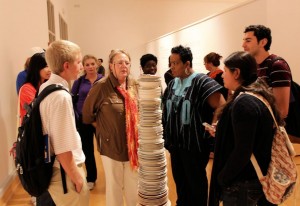 To find the objects she needs, Frorup channels her inner Macklemore and frequents thrift shops, Good Wills, and garage sales. “I also like driving through old neighborhoods on garbage days,” she confesses. “I’m on the look out 24/7, and now people leave items for me in my yard. Sometimes I’m drawn to pieces and on other occasions I may be looking for something specific. But either way,
To find the objects she needs, Frorup channels her inner Macklemore and frequents thrift shops, Good Wills, and garage sales. “I also like driving through old neighborhoods on garbage days,” she confesses. “I’m on the look out 24/7, and now people leave items for me in my yard. Sometimes I’m drawn to pieces and on other occasions I may be looking for something specific. But either way, 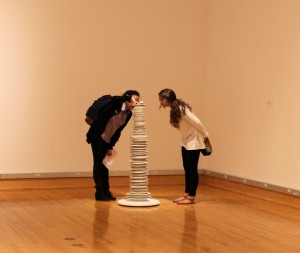 my mind keeps wandering back and forth between the present and the past, between old and new.”
my mind keeps wandering back and forth between the present and the past, between old and new.”
The self-deprecating Frorup got a bit of a fright not too long ago. “My mom died recently and as we were cleaning out her house, I realized she was a hoarder. She didn’t look like a hoarder because she had it so organized, but there was a lot of stuff in that house. Now I don’t look much like my mother, but I am her.”
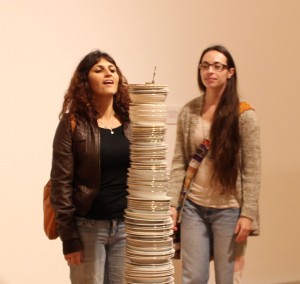 But in her defense, Kendra is willing to part with the items she collects, “although it may be 10 or 12 years before I sue something in one of my artworks.”
But in her defense, Kendra is willing to part with the items she collects, “although it may be 10 or 12 years before I sue something in one of my artworks.”
One aspect of Kendra’s sculptural compositions that seemed to intrigue gallery visitors most is the way she juxtaposes the column-like stacks of cups and saucers in her works with miniature sculptures balanced on top “as if by magic.” But there’s no slight of hand. “They are the way that 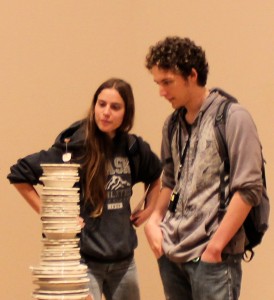 they are by very specific design,” Kendra adds. “It’s important to me how it’s done.” She comes by that sentiment honestly. Her dad is a contractor.
they are by very specific design,” Kendra adds. “It’s important to me how it’s done.” She comes by that sentiment honestly. Her dad is a contractor.
It’s also important to Frorup that the objects she incorporates into her artwork maintain their integrity so as to reflect what they were and where they have been. In this way, she fashions works that uniquely reflect who she is and the cultural motivations that influence her as an artist.
“My work delves into a personal history formed by a 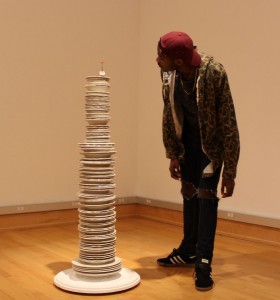 different cultural motivation through investigation of materials and their evocative qualities,” Kendra expounds. “Through the process of conceiving and working through ideas, the viewer can identify main interests and recurring themes in my work.”
different cultural motivation through investigation of materials and their evocative qualities,” Kendra expounds. “Through the process of conceiving and working through ideas, the viewer can identify main interests and recurring themes in my work.”
Frorup received a B.A. in Sculpture from the University of Tampa in 1992, and her MFA from Syracuse in 1996. She is presently an assistant professor in sculpture at the University of Tampa, and from her Bahamian heritage comes a sense of identity and a strong work ethic.
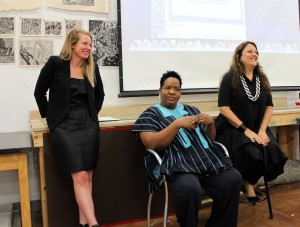 And what are the sounds, smells and tastes she most associates with her native Nassau?
And what are the sounds, smells and tastes she most associates with her native Nassau?
“My country sounds of coconuts falling from a tree. My country tastes like sugar cane, sour gineap, goose berries and jelly coconut water,” she posts on her website. “My country smells like Sunday lunches, Mortimer coconut cream cakes, peanut candy and parching benny.” With that as her benchmark, foraging forays for found objects can prove quite interesting.
BeLonging is on view now through February 26. Florida Gulf Coast University is located at 10501 FGCU Blvd. South, Fort Myers, FL 33965-6565. For more information, please telephone 239-590-1000 or 800-590-3428.
___________________________________________________________________________
Noelle Mason tapestries and embroideries confront borders from novel perspective (01-21-15)
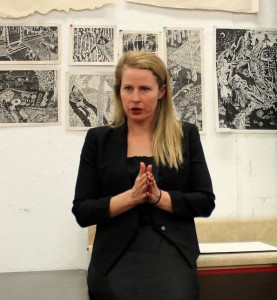 On view now through February 22 in the Art Gallery at FGCU is BeLonging: Caputo, Frorup, Mason. Part of the Current Series focusing on noteworthy regional artists, the works on exhibition explore the complexities surrounding physical and political borders and how they impact memory, family, and the concept of home.
On view now through February 22 in the Art Gallery at FGCU is BeLonging: Caputo, Frorup, Mason. Part of the Current Series focusing on noteworthy regional artists, the works on exhibition explore the complexities surrounding physical and political borders and how they impact memory, family, and the concept of home.
Noelle Mason is interested primarily in the ways by which visual and non-visual datasets, paperwork, and photographic as well as non-photographic visualization shapes our individual experience of collective trauma. 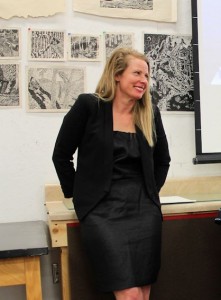 Through sculpture, performance art, and craft, her work examines the way mediation affects our response to traumatic events.
Through sculpture, performance art, and craft, her work examines the way mediation affects our response to traumatic events.
For BeLonging, Mason brought along two woven gobelin rugs depicting satellite images of the U.S./Mexico border and several hand-stitched embroideries of infrared images of undocumented immigrants crossing into the United States. These works are part of her Human Hunting series, a body of work that investigates the phenomenological effects of vision technologies on the perception of undocumented immigrants. Human Hunting unfolds two-dimensional images into three-dimensional structures to expose how new vision technologies such as backscatter, x-ray, sonic, 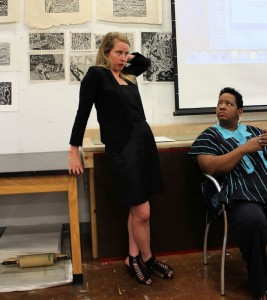 thermal and digital imaging recycle Cartesian modes of rationalization of geography and the body and, in so doing, reinforces a neo-colonial social and political relationship with Mexico. “This neo-colonial worldview in post-colonial clothing leads to a fortification of the physical border and permeability of the economic border allowing an unbalanced or parasitic exploitation of natural (water) and human (labor) resources,” Mason maintains.
thermal and digital imaging recycle Cartesian modes of rationalization of geography and the body and, in so doing, reinforces a neo-colonial social and political relationship with Mexico. “This neo-colonial worldview in post-colonial clothing leads to a fortification of the physical border and permeability of the economic border allowing an unbalanced or parasitic exploitation of natural (water) and human (labor) resources,” Mason maintains.
Mason gives the tapestries the collective name of Ground Control. The two on display in the Art Gallery at FGCU 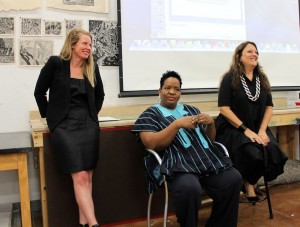 are part of a planned 5-piece set. Mason got the idea for them when she happened across pictures taken by the Advanced Spaceborne Thermal Emission and Reflection Radiometer (ASTER) device aboard the Terra satellite. While ASTER mainly creates geological images, the ones that most appealed to Mason depicted the border between California and Mexico that drains the Colorado River.
are part of a planned 5-piece set. Mason got the idea for them when she happened across pictures taken by the Advanced Spaceborne Thermal Emission and Reflection Radiometer (ASTER) device aboard the Terra satellite. While ASTER mainly creates geological images, the ones that most appealed to Mason depicted the border between California and Mexico that drains the Colorado River.
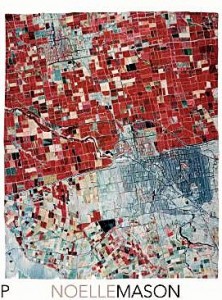 “This one is the border between Mexico and California,” Mason explained to the Standing Room Only Gallery Talk that preceded the exhibition’s January 15 opening. “The top half is the Imperial Valley and the bottom half is Mexicali. This is an area of California through which the Colorado River flows and where many of the crops that are sold throughout the U.S. are grown. But as a result, by the time the Colorado River reaches Mexico, the water in the river is all but gone. This is the source of a water war that’s been going on between the U.S. and Mexico.”
“This one is the border between Mexico and California,” Mason explained to the Standing Room Only Gallery Talk that preceded the exhibition’s January 15 opening. “The top half is the Imperial Valley and the bottom half is Mexicali. This is an area of California through which the Colorado River flows and where many of the crops that are sold throughout the U.S. are grown. But as a result, by the time the Colorado River reaches Mexico, the water in the river is all but gone. This is the source of a water war that’s been going on between the U.S. and Mexico.”
Having found the image, Mason knew she wanted to do something with it but wasn’t sure what that was at the time. “But then I came across a process of weaving that is called gobelin tapestry making.”
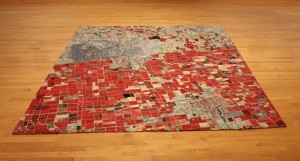 Tapestries are created by weaving interlaced horizontal and vertical strands of thread on a device known as a loom. The threads running parallel to the length of the tapestry are known as “warp,” and those extending parallel to the tapestry’s width are called “weft.” The warp
Tapestries are created by weaving interlaced horizontal and vertical strands of thread on a device known as a loom. The threads running parallel to the length of the tapestry are known as “warp,” and those extending parallel to the tapestry’s width are called “weft.” The warp 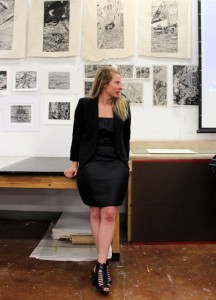 threads are set up under tension on the loom and the weft threads are passed back and forth across all or part of the warps.
threads are set up under tension on the loom and the weft threads are passed back and forth across all or part of the warps.
While tapestry making dates back to ancient Egypt and Greece, those woven at the Gobelin factory outside Paris in the 1600s and 1700s are regarded to be among the finest ever made. They were so good, in fact, that in 1662 France’s King Louis XIV’s minister of finance, Jean-Baptiste Colbert, took over the Gobelins manufactory on behalf of the Crown, and its official title became Manufacture Royale des Meubles de la Couronne (Royal Factory of Furniture to the Crown). The manufactory’s first director, Charles Le Brun, orchestrated numerous craftsmen, including tapestry weavers, 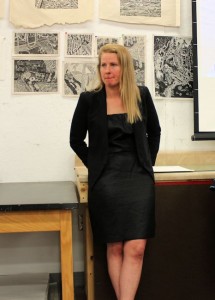 painters (including Jean-Baptiste Oudry, Charles Coypel and Francois Boucher), bronze-workers, furniture-makers, and gold- and silversmiths, who supplied objects exclusively for the king’s palaces or as royal gifts.
painters (including Jean-Baptiste Oudry, Charles Coypel and Francois Boucher), bronze-workers, furniture-makers, and gold- and silversmiths, who supplied objects exclusively for the king’s palaces or as royal gifts.
“It’s a hand-woven process; not machine made,” Mason imparted to the FGCU crowd. “All hand knotted, and all but lost to the ages after machine weaving was developed. But a group of artisans in Guadalajara [the Taller Mexicano de Gobelinos] have continued to produce these tapestries, and so it seemed appropriate to have this image made by them, and it became a type of performance in which I asked them to make the scale of the rug equivalent to what it would cost a family of four to illegally immigrate to the United States.”
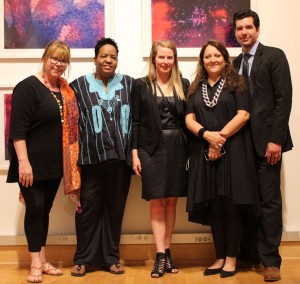 Each of the five Ground Control tapestries will represent a border conflict between the United States and Mexico. But Mason is also interested in the borders of the tapestries themselves. “They present a temptation to cross their border and step onto the surface of the rug,” she confided to the consternation of co-curators John Loscuito and Anica Sturdivant. Mason is also intrigued by the fact that scene depicted in the satellite image is as completely removed from human experience as the colors, which are produced by electromagnetic
Each of the five Ground Control tapestries will represent a border conflict between the United States and Mexico. But Mason is also interested in the borders of the tapestries themselves. “They present a temptation to cross their border and step onto the surface of the rug,” she confided to the consternation of co-curators John Loscuito and Anica Sturdivant. Mason is also intrigued by the fact that scene depicted in the satellite image is as completely removed from human experience as the colors, which are produced by electromagnetic 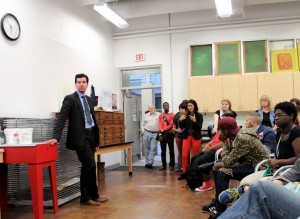 radiation. “So I was interested in remediating this image into something more tactile, which is why I put it on the floor instead of hanging it from a wall, which has a more confrontational connotation to it.”
radiation. “So I was interested in remediating this image into something more tactile, which is why I put it on the floor instead of hanging it from a wall, which has a more confrontational connotation to it.”
Noelle calls the second component of her Human Hunting series X-ray Vision vs. Invisibility. “These 12 embroideries are based on images from 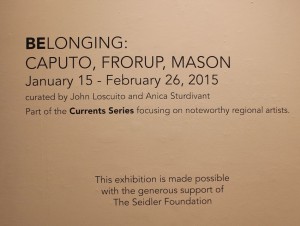 the Minuteman website,” Mason explains. The Minuteman Project is an activist organization started in April 2005 by a group of private individuals in the United States to monitor the United States – Mexico border’s flow of illegal immigrants. Co-founded by Jim Gilchrist, the name derives from the Minutemen, militiamen who fought in the American Revolution. The Minuteman Project describes itself as “a citizens’
the Minuteman website,” Mason explains. The Minuteman Project is an activist organization started in April 2005 by a group of private individuals in the United States to monitor the United States – Mexico border’s flow of illegal immigrants. Co-founded by Jim Gilchrist, the name derives from the Minutemen, militiamen who fought in the American Revolution. The Minuteman Project describes itself as “a citizens’ 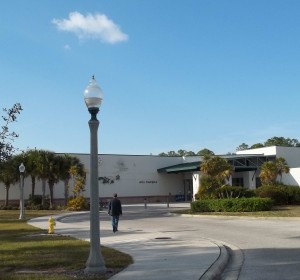 Neighborhood Watch on our border”, and has attracted media attention to illegal immigration. “They are a vigilante group that uses surveillance and other types of technologies to control the border on their own. The images [I’ve appropriated for the embroideries] are of ‘load trucks.’”
Neighborhood Watch on our border”, and has attracted media attention to illegal immigration. “They are a vigilante group that uses surveillance and other types of technologies to control the border on their own. The images [I’ve appropriated for the embroideries] are of ‘load trucks.’”
Half of the 12 embroideries were made by Mason and half were hand embroidered by Bilú Alcântara in Mexico in exchange for the amount it would cost 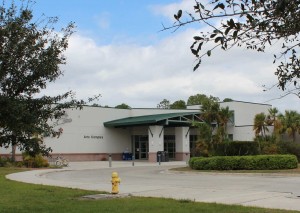 her to illegally immigrate to the United States. “All materials were made and purchased in the United States then one-half were sent with instructions to be produced by Bilú, while the other half remained in the United States and were embroidered by myself,” Mason revealed. “But they’re made in such a way you don’t know which half is made by me and which half is made by Bilu.”
her to illegally immigrate to the United States. “All materials were made and purchased in the United States then one-half were sent with instructions to be produced by Bilú, while the other half remained in the United States and were embroidered by myself,” Mason revealed. “But they’re made in such a way you don’t know which half is made by me and which half is made by Bilu.”
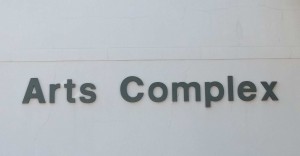 The production method is intended as a metaphor for the exportation of manual labor across border while the remediation of infrared and backscatter surveillance seductively aestheticizes the business of border crossing. “It gets at the concept of labor as a commodity, and what it means to move that commodity from a place where labor is pretty much tied to an hourly wage to what is basically the virtual market of the art world where things get compensated in ways that are somewhat suspect.”
The production method is intended as a metaphor for the exportation of manual labor across border while the remediation of infrared and backscatter surveillance seductively aestheticizes the business of border crossing. “It gets at the concept of labor as a commodity, and what it means to move that commodity from a place where labor is pretty much tied to an hourly wage to what is basically the virtual market of the art world where things get compensated in ways that are somewhat suspect.”
BeLonging is on view now through February 26. Florida Gulf Coast University is located at 10501 FGCU Blvd. South, Fort Myers, FL 33965-6565. For more information, please telephone 239-590-1000 or 800-590-3428.
______________________________________________________________________________________________
Miami artist Amalia Caputo’s work in FGCU’s ‘Belonging’ exhibit is deep, profound and thought-provoking (01-20-15)
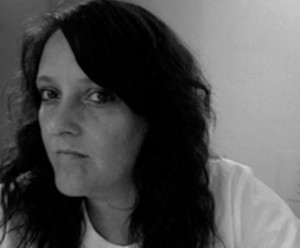 On view now through February 22 in the Art Gallery at FGCU is BeLonging: Caputo, Frorup, Mason. Part of the Current Series focusing on noteworthy regional artists, the works on exhibition explore the complexities surrounding physical and political borders and how they impact memory, family, and the concept of home.
On view now through February 22 in the Art Gallery at FGCU is BeLonging: Caputo, Frorup, Mason. Part of the Current Series focusing on noteworthy regional artists, the works on exhibition explore the complexities surrounding physical and political borders and how they impact memory, family, and the concept of home.
Amalia Caputo offers the exhibition’s viewers samples from four of her provocative series of 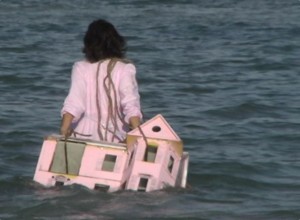 photo and video based work. House of Hestia is the one that first caught the eye of co-curator and Gallery Director John Loscuito (see next article). Highlighted in this component of Caputo’s portion of the show are two photos and a beautifully-crafted video that depicts a woman in a pink dress dragging a pink dollhouse into the lapping waves of frothy surf.
photo and video based work. House of Hestia is the one that first caught the eye of co-curator and Gallery Director John Loscuito (see next article). Highlighted in this component of Caputo’s portion of the show are two photos and a beautifully-crafted video that depicts a woman in a pink dress dragging a pink dollhouse into the lapping waves of frothy surf.
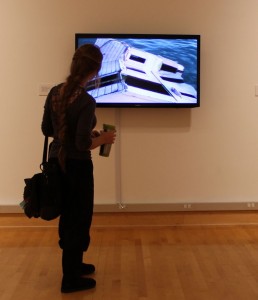 Like most of her work, these pieces are multi-metaphorical. On a rudimentary plane, she asks us to think about how the place in which we live and the objects we choose to collect express our unique personal narrative. “The world today allows us to move freely, which challenges us to think about what it is that we want to bring along during these moves and changes of place,” said Caputo in a recent telephone interview. But on a deeper level, House of Hestia calls into play notions about gender, femininity and domesticity.
Like most of her work, these pieces are multi-metaphorical. On a rudimentary plane, she asks us to think about how the place in which we live and the objects we choose to collect express our unique personal narrative. “The world today allows us to move freely, which challenges us to think about what it is that we want to bring along during these moves and changes of place,” said Caputo in a recent telephone interview. But on a deeper level, House of Hestia calls into play notions about gender, femininity and domesticity.
Hestia is the Greek goddess of the hearth. Recognizing the critical importance of fire to ancient clans and 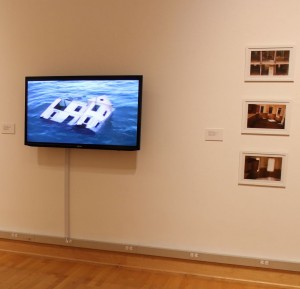 communities, Hestia symbolized warmth, comfort and sanctuary for the family and state as a whole. Throughout history, women have been associated with creating and keeping the home, but even as increasing numbers of women are preferring careers over childrearing and homemaking, Caputo believes that there exists an unconscious tug if not primal, species-based instinct in women to make a place of safety and comfort for themselves and members of their families, no matter how loosely-defined that definition may be.
communities, Hestia symbolized warmth, comfort and sanctuary for the family and state as a whole. Throughout history, women have been associated with creating and keeping the home, but even as increasing numbers of women are preferring careers over childrearing and homemaking, Caputo believes that there exists an unconscious tug if not primal, species-based instinct in women to make a place of safety and comfort for themselves and members of their families, no matter how loosely-defined that definition may be.
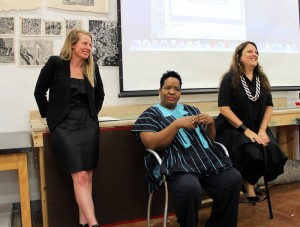 “But the house is not only the repository for the body, the body is also the repository for the house inside the person,” Caputo maintained Yoda-like to a rapt audience during the Gallery Talk that preceded last Thursday’s opening. Pop jargon employs the visual-qua-visceral term crib. Caputo provides an alternative picture – a nest with tentacles descending into her subject’s brain. “You bring your own nest to the home and the world beyond,” Amalia expounds. “There’s an interconnection between home and body, body and home.”
“But the house is not only the repository for the body, the body is also the repository for the house inside the person,” Caputo maintained Yoda-like to a rapt audience during the Gallery Talk that preceded last Thursday’s opening. Pop jargon employs the visual-qua-visceral term crib. Caputo provides an alternative picture – a nest with tentacles descending into her subject’s brain. “You bring your own nest to the home and the world beyond,” Amalia expounds. “There’s an interconnection between home and body, body and home.”
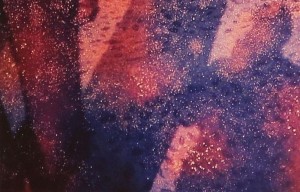 It’s a thread that Caputo weaves further in Relentless, a series that conjures images of different spaces which we have once occupied and in which we leave an imprint that lives on even though we have moved to a new and different space. Caputo is not suggesting an alternate reality or parallel world as much as a homeopathic-like
It’s a thread that Caputo weaves further in Relentless, a series that conjures images of different spaces which we have once occupied and in which we leave an imprint that lives on even though we have moved to a new and different space. Caputo is not suggesting an alternate reality or parallel world as much as a homeopathic-like 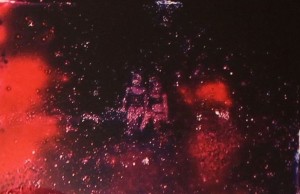 energy residue. It’s an intriguing prospect, but Caputo leaves it to others to ascertain whether that imprint can be tuned and calibrated to recapture our memories of that place and the time we spent there.
energy residue. It’s an intriguing prospect, but Caputo leaves it to others to ascertain whether that imprint can be tuned and calibrated to recapture our memories of that place and the time we spent there.
But Caputo’s most profound body of work is encapsulated in Memories of Oblivion, a series in 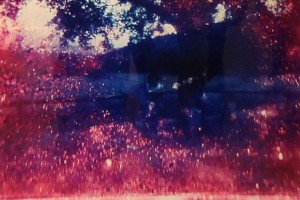 which she has recovered slides of her childhood. “They were in pretty bad shape,” Caputo admitted to the Gallery Talk crowd. “They were covered with mold and degrading. I treated them with fire and vinegar, digitized them and printed them off. The resulting images are blurry, just like the actual moments are in my memory.”
which she has recovered slides of her childhood. “They were in pretty bad shape,” Caputo admitted to the Gallery Talk crowd. “They were covered with mold and degrading. I treated them with fire and vinegar, digitized them and printed them off. The resulting images are blurry, just like the actual moments are in my memory.”
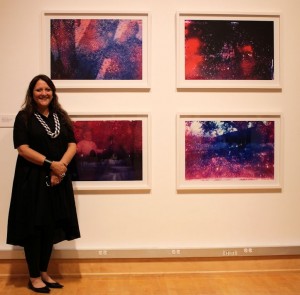 That experience caused Caputo to question the role that photography plays in creating a permanent link to or dialogue with our fragile memories of the people, places and objects that populate our lives. “When we go back and look at a photo album containing images we kept or that our parents or even our grandparents kept, the photographs become objects – physical links to permanence that lock memory into a physical support.” But in today’s digital world of Facebook, Flickr, Instagram, Pinterest and Twitter, our images may
That experience caused Caputo to question the role that photography plays in creating a permanent link to or dialogue with our fragile memories of the people, places and objects that populate our lives. “When we go back and look at a photo album containing images we kept or that our parents or even our grandparents kept, the photographs become objects – physical links to permanence that lock memory into a physical support.” But in today’s digital world of Facebook, Flickr, Instagram, Pinterest and Twitter, our images may 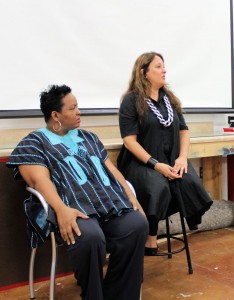 have more immediacy (since there’s no longer any film to develop or process), but they are far more ephemeral.
have more immediacy (since there’s no longer any film to develop or process), but they are far more ephemeral.
“Photographs have long been understood as testimony of events that have happened,” Caputo insists. “We are taking more images of ourselves than ever before, but all of our selfies and snapshots are being taken minute by minute up into the Cloud where they disappear because they aren’t archived and cannot be retrieved easily, if at all.” And this is causing Amalia to wonder in Memories of Oblivion what’s going to happen when people come to realize that that a medium and technology that has for 150 years carried the weight and responsibility of 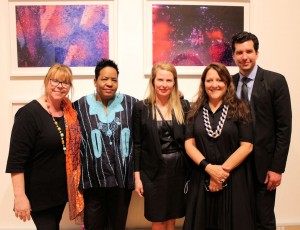 preserving our memories is fading because our images are being stored almost exclusively in nonphysical formats such as “numbers, computer code and the Cloud.”
preserving our memories is fading because our images are being stored almost exclusively in nonphysical formats such as “numbers, computer code and the Cloud.”
“It’s a thought that runs parallel to what’s happened in my country [of birth]. Since I left 20 years ago, Venezuela has gone through tremendous change, and the places in those slides 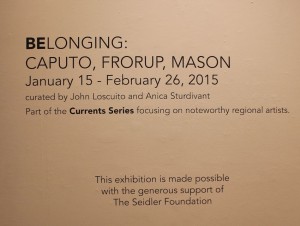 no longer exist …. At least not as they did two decades ago.” Without her photographs, all she would have are fuzzy, fading, unreliable glimmers of memory, which is all that Boomlets, Millennials and Gen-Xers will have if they continue to post the images they take with their smart phones and tablets in social media without taking the time or care to place copies in properly-backed electronic files or more traditional photo albums.
no longer exist …. At least not as they did two decades ago.” Without her photographs, all she would have are fuzzy, fading, unreliable glimmers of memory, which is all that Boomlets, Millennials and Gen-Xers will have if they continue to post the images they take with their smart phones and tablets in social media without taking the time or care to place copies in properly-backed electronic files or more traditional photo albums.
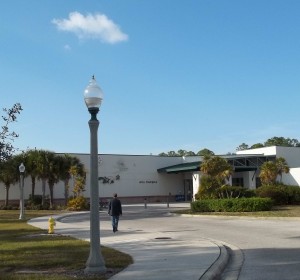 Amalia Caputo has a B.A. in Art and Art History from the Universidad Central de Venezuela and her MFA in Studio Art/ Photography from New York University and the International Center of Photography. She describes herself as a photo and video based artist who deals with multiple subjects with the human body serving as the core of her work. She concentrates on exploring in-depth the medium itself, along with the presence of the corporeal or its absence, in ways that are related
Amalia Caputo has a B.A. in Art and Art History from the Universidad Central de Venezuela and her MFA in Studio Art/ Photography from New York University and the International Center of Photography. She describes herself as a photo and video based artist who deals with multiple subjects with the human body serving as the core of her work. She concentrates on exploring in-depth the medium itself, along with the presence of the corporeal or its absence, in ways that are related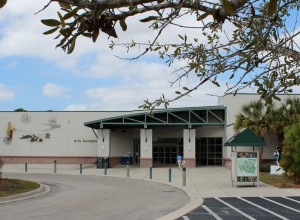 time, art history, memory, narrative, theatricality, and ultimately, as an archive of ideas.
time, art history, memory, narrative, theatricality, and ultimately, as an archive of ideas.
Since 1989, Amalia Caputo has exhibited widely in museums and galleries in her native Caracas, as well as in Barcelona, London, Mexico, Taipei, Miami, New York and D.C. In 2006, she showcased a solo exhibition titled Fe, Cuerpo y Artificio that was curated by Costanza De Rogatis, 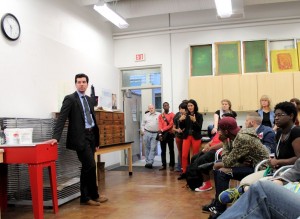 at the Museo Alejandro Otero in Caracas and Museo de Arte Acarigua Araure in Venezuela. More recently, Caputo had a solo exhibition titled Tableaux at Dot Fifty One Gallery in Miami in 2010. Amalia is the recipient of numerous awards and honors. Her work is represented in various public and private collections including those of the Galeria de Arte Nacional in Caracas Venezuela, the Fundación Banco Mercantil Collection in Caracas, Museum of Latin American Art – Molaa in Los Angeles, and the Ella Fontanals Cisneros Collection and the Arturo and Liza Mosquera in Miami.
at the Museo Alejandro Otero in Caracas and Museo de Arte Acarigua Araure in Venezuela. More recently, Caputo had a solo exhibition titled Tableaux at Dot Fifty One Gallery in Miami in 2010. Amalia is the recipient of numerous awards and honors. Her work is represented in various public and private collections including those of the Galeria de Arte Nacional in Caracas Venezuela, the Fundación Banco Mercantil Collection in Caracas, Museum of Latin American Art – Molaa in Los Angeles, and the Ella Fontanals Cisneros Collection and the Arturo and Liza Mosquera in Miami.
BeLonging is on view now through February 26. Florida Gulf Coast University is located at 10501 FGCU Blvd. South, Fort Myers, FL 33965-6565. For more information, please telephone 239-590-1000 or 800-590-3428.
_________________________________________________________
The making of the Art Gallery at FGCU exhibition ‘BeLonging’ (01-17-15)
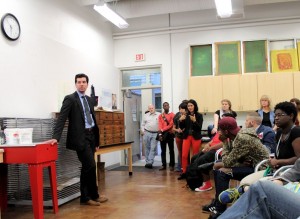 BeLonging: Caputo, Frorup, Mason opened Thursday night (January 15) inside the Art Gallery at FGCU. Part of the Current Series focusing on noteworthy regional artists, the works in the exhibition explore the complexities surrounding physical and political borders and how they impact memory, family, and the concept of home.
BeLonging: Caputo, Frorup, Mason opened Thursday night (January 15) inside the Art Gallery at FGCU. Part of the Current Series focusing on noteworthy regional artists, the works in the exhibition explore the complexities surrounding physical and political borders and how they impact memory, family, and the concept of home.
“The idea for BeLonging came about nine or so months ago when I saw work by Amalia Caputo on a postcard of a person pulling a house,” explained FGCU Gallery Director John Loscuito during the Gallery Talk preceding the show’s opening. “I got to thinking about what it means to have a home, to belong to a place and have a history with that place, and what happens when you leave that place and have to decide what to take along with you. 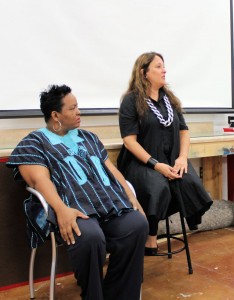 Out of that, [co-curator] Anica [Sturdivant] and I started scanning the web for artists whose work addresses similar themes.” Together, Loscuito and Sturdivant took off on a dozen visits to studios in Tampa and Miami in search of complementary works. “It’s one thing to see works on the web and another to see them in person, meet the artists and get to know them.”
Out of that, [co-curator] Anica [Sturdivant] and I started scanning the web for artists whose work addresses similar themes.” Together, Loscuito and Sturdivant took off on a dozen visits to studios in Tampa and Miami in search of complementary works. “It’s one thing to see works on the web and another to see them in person, meet the artists and get to know them.”
Their trips proved fruitful. “We were so fortunate to find two other artists what carried that thread through their work,” Loscuito amplified. “The artists did not [previously] know each other, so it’s very rewarding to not only bring their work to 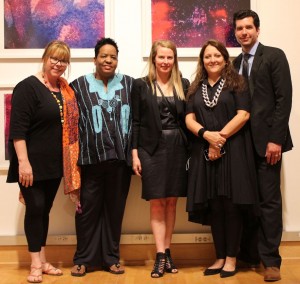 FGCU and the surrounding community, but to allow them to get to know each other and see how their work relates to each other in context.”
FGCU and the surrounding community, but to allow them to get to know each other and see how their work relates to each other in context.”
Loscuito and Sturdivant decided to exhibit their work side by side, rather than segregating each artist’s works into separate areas of the main gallery. The decision not only metaphorically underscores that the artwork extends beyond the bounds of this exhibition, it provides interconnected yet distinctive windows into the 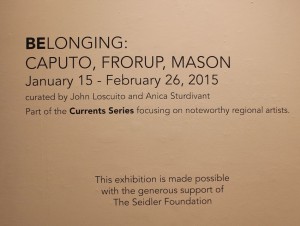 challenges of living and working in global society denoted by shifting political, social and economic realities. The concepts of a physical home that we construct and cherish, our own physical bodies that migrate and persevere, and our psychological needs for family and community, are all present here. It is these shared experiences that connect us even though borders, politics and economics tend to separate us.
challenges of living and working in global society denoted by shifting political, social and economic realities. The concepts of a physical home that we construct and cherish, our own physical bodies that migrate and persevere, and our psychological needs for family and community, are all present here. It is these shared experiences that connect us even though borders, politics and economics tend to separate us.
BeLonging is on view now through February 26. Florida Gulf Coast University is located at 10501 FGCU Blvd. South, Fort Myers, FL 33965-6565. For more information, please telephone 239-590-1000 or 800-590-3428.
______________________________________________________________________________________________
Work by three noteworthy regional artists goes on view at the Art Gallery at FGCU on Thursday, January 15 (01-11-15)
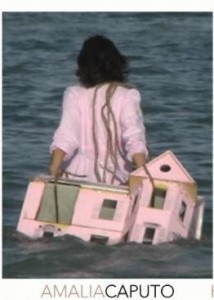 BeLonging: Caputo, Frorup, Mason opens Thursday (January 15) at the Art Gallery at FGCU. Curated by John Loscuito and Anica Sturdivant as part of the Currents Series focusing on noteworthy regional artists, BeLonging brings together three artists working in different media and coming from diverse backgrounds, Amalia Caputo, Kendra Frorup and Noelle Mason. In this show, their work is exhibited side by side in the gallery in order to explore the complexities surrounding physical and political borders and how they impact memory, family, and the concept of home.
BeLonging: Caputo, Frorup, Mason opens Thursday (January 15) at the Art Gallery at FGCU. Curated by John Loscuito and Anica Sturdivant as part of the Currents Series focusing on noteworthy regional artists, BeLonging brings together three artists working in different media and coming from diverse backgrounds, Amalia Caputo, Kendra Frorup and Noelle Mason. In this show, their work is exhibited side by side in the gallery in order to explore the complexities surrounding physical and political borders and how they impact memory, family, and the concept of home.
The content of the artwork extends beyond the bounds of this exhibition. Their works provide three distinct windows into the 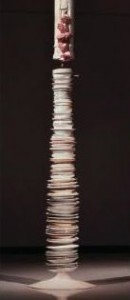 challenges of living and working in our current global society with its shifting political and economic realities.
challenges of living and working in our current global society with its shifting political and economic realities.
Amalia Caputo’s photographs convey how memory can disintegrate and fade over time. Her video and stills are a performance capturing her efforts to transport a “home” across vast distances.
The work of Kendra Frorup uses found objects and materials to capture the physical presence of a place and experiences. The fragile nature of life and family is present in her work coupled with the strength to endure.
Noelle Mason’s tapestries are complicated objects that represent the personal and impersonal nature of borders and geography. The hand knotted construction of the 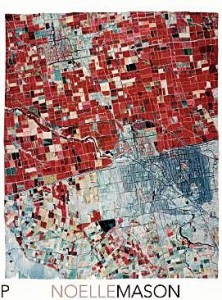 pieces is in conflict with the subject matter, which removes the human connection.
pieces is in conflict with the subject matter, which removes the human connection.
The concepts of a physical home that we construct and cherish, our own physical bodies that migrate and persevere, and our psychological needs for family and community, are all present here. It is these shared experiences that connect us even though borders, politics and economics tend to separate us.
The exhibition opens with a Gallery Talk at 5 p.m. in the Arts Complex Printmaking Studio and is followed by a reception that extends to 8 p.m. BeLonging runs through February 26. Florida Gulf Coast University is located at 10501 FGCU Blvd. South, Fort Myers, FL 33965-6565. For more information, please telephone 239-590-1000 or 800-590-3428.














 Tom Hall is both an amateur artist and aspiring novelist who writes art quest thrillers. He is in the final stages of completing his debut novel titled "Art Detective," a story that fictionalizes the discovery of the fabled billion-dollar Impressionist collection of Parisian art dealer Josse Bernheim-Jeune, thought by many to have perished during World War II when the collection's hiding place, Castle de Rastignac in southern France, was destroyed by the Wehrmacht in reprisal for attacks made by members of the Resistance operating in the area. A former tax attorney, Tom holds a bachelor's degree as well as both a juris doctorate and masters of laws in taxation from the University of Florida. Tom lives in Estero, Florida with his fiancee, Connie, and their four cats.
Tom Hall is both an amateur artist and aspiring novelist who writes art quest thrillers. He is in the final stages of completing his debut novel titled "Art Detective," a story that fictionalizes the discovery of the fabled billion-dollar Impressionist collection of Parisian art dealer Josse Bernheim-Jeune, thought by many to have perished during World War II when the collection's hiding place, Castle de Rastignac in southern France, was destroyed by the Wehrmacht in reprisal for attacks made by members of the Resistance operating in the area. A former tax attorney, Tom holds a bachelor's degree as well as both a juris doctorate and masters of laws in taxation from the University of Florida. Tom lives in Estero, Florida with his fiancee, Connie, and their four cats.